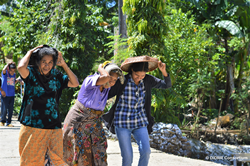
A community in Indonesia is running a disaster risk reduction simulation drill ©DiDRR Consortium
“…[W]e must admit that little has been achieved around the inclusion of persons with disabilities in disaster preparation, response, and recovery,” said Vladimir Cuk, Executive Director of the International Disability Alliance.
GENEVA (PRWEB)
May 19, 2022
“It has now been 7 years since we were in Sendai, Japan to discuss how to build a more resilient world while facing more disasters. In 2015, IDA, as an organization of persons with disabilities, was excited to see strong provisions on disability-inclusive Disaster Risk Reduction in the Sendai Framework. But packing for Bali to discuss progress in implementing what we had agreed in Sendai, we must admit that little has been achieved around the inclusion of persons with disabilities in disaster preparation, response, and recovery,” said Vladimir Cuk, Executive Director of the International Disability Alliance (IDA).
Recovering from the Covid-19 pandemic and concerned how to tackle climate change, world leaders, civil society and United Nations agencies are gathering in Bali, Indonesia to participate in the Seventh Global Platform for Disaster Risk Reduction (23-28 May 2022). The theme is “From Risk to Resilience: Towards Sustainable Development for All in a COVID-19 Transformed World”.
In this altered world, human rights are as relevant as ever in emergency response and Disaster Risk Reduction. Respecting and upholding human rights is a pre-condition to ensuring that the different requirements of the population – before, during and after emergencies – are taken into account and contribute to strengthening resilience, particularly for the most marginalized groups.
Persons with disabilities, particularly in the Global South, are disproportionately affected by disasters, facing higher risk of death, injury, displacement, and property loss. Discrimination based on disability, age and gender often combines with other indirect forms of discrimination, denying people their right to assistance, protection, and participation in disaster management.
The preparedness and mitigation mechanisms addressing disaster risks are still not inclusive of the rights of persons with disabilities. As a result, persons with disabilities are more likely to be left behind during emergencies, with a death rate at least twice as high as that of the general affected population. Covid-19 has shown a blatant example of how pre-existing patterns of discrimination and exclusion have had a disproportionate impact on persons with disabilities, particularly underrepresented groups.
Ensuring inclusion and participation of all persons with disabilities in situations of risk and during emergency response is laid out in Article 11 of the Convention on the Rights of Persons with Disabilities and must be considered a core component of principled and effective humanitarian action, including Disaster Risk Reduction.
IDA, a representative organization of more than 1,100 organizations of persons with disabilities worldwide, believes that an effective Disaster Risk Reduction is the one that addresses the root causes of disasters – which lay in societal vulnerabilities, in unaccommodated needs, disempowered strengths and unbuilt capacities of the population at risk.
“The Covid-19 pandemic has clearly shown that a paradigm shift must occur in dealing with global-scale humanitarian and environmental crisis. The only successful way to overcome and prevent such crisis is one that does not leave anyone behind. Where persons with disabilities and their representative organizations are recognized as agents of change, they have the opportunity to serve in leading positions to tackle global problems, and their experiences are valued in all sectors of life,” said Cuk.
IDA calls on all participants at the Global Platform to bring human rights back into the conversation, by following a “twin-track approach” to Disaster Risk Reduction, as enshrined in the Convention. Empower people with disabilities by building capacity and reducing vulnerabilities, on one side. Develop inclusive Disaster Risk Reduction policies to increase awareness of people’s requirements and capabilities and improve the preparation and training of disaster practitioners, on the other.
Ensuring a human rights-based and disability-inclusive perspective in pre-emergency phases is crucial to effectively protect persons with disabilities during the most acute phases of the emergency – choices made during the preparation stage have crucial repercussions on durable reconstruction and on the long-term mitigation of human suffering. We will not achieve a sustainable and resilient society if all human rights of all persons are not protected, respected, and upheld.
Learn more about the recommendations by the Stakeholders Group of Persons with Disabilities Thematic Group on Disaster Risk Reduction and Climate Action.
___
About the International Disability Alliance (IDA)
IDA, established in 1999, is a network of eight global and six regional organizations of persons with disabilities (OPDs). IDA members, and their members, represent over 1100 OPDs from across 182 countries and the estimated one billion persons with disabilities worldwide. Its mission is to advance the human rights of persons with disabilities as a united voice of organizations of persons with disabilities utilizing the Convention on the Rights of Persons with Disabilities and other human rights instruments. The 14 members of IDA are: the African Disability Forum (ADF); the ASEAN Disability Forum (AsDF); the Arab Organization of Persons with Disabilities (AOPD); Down Syndrome International (DSI); the European Disability Forum (EDF); Inclusion International (II); the International Federation of Hard of Hearing People (IFHOH); the International Federation of Spina Bifida and Hydrocephalus (IFSBH); the Latin American Network of Non-Governmental Organizations of Persons with Disabilities and their Families (RIADIS); the Pacific Disability Forum (PDF); the World Blind Union (WBU); the World Federation of the Deaf (WFD); the World Federation of the Deafblind (WFDB); and the World Network of Users and Survivors of Psychiatry (WNUSP). For more information, please visit: http://www.internationaldisabilityalliance.org/
Share article on social media or email:

